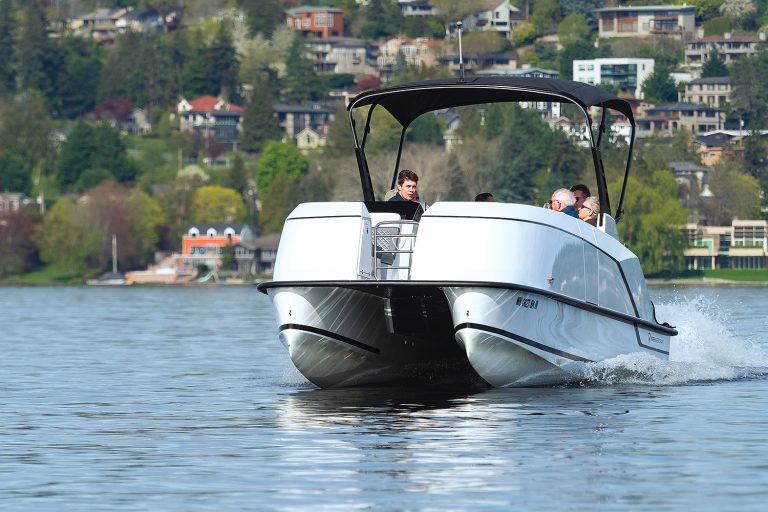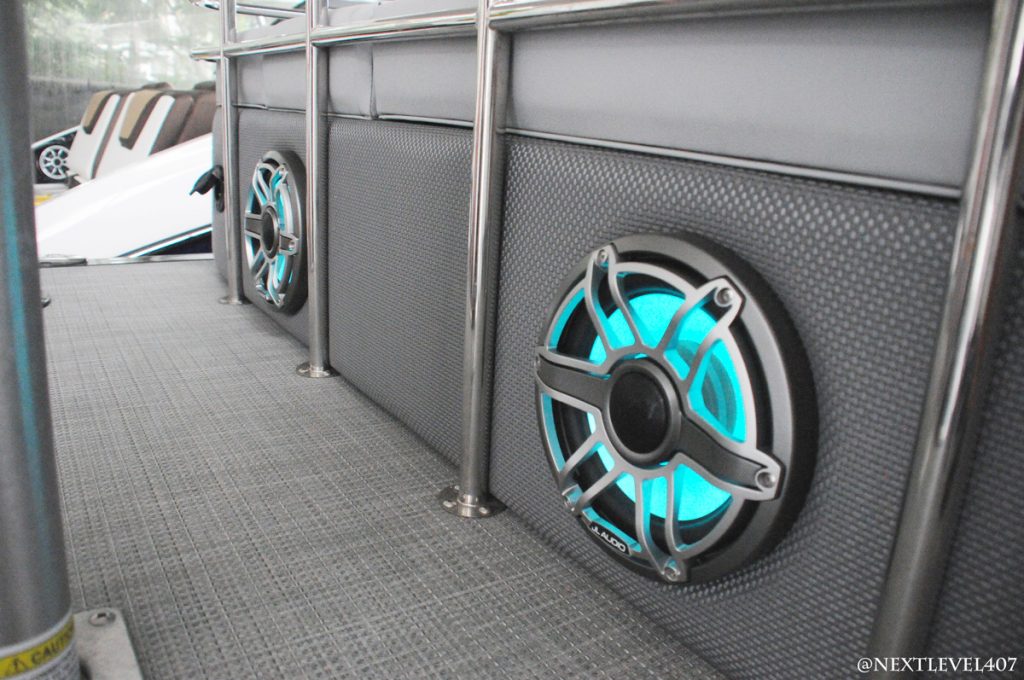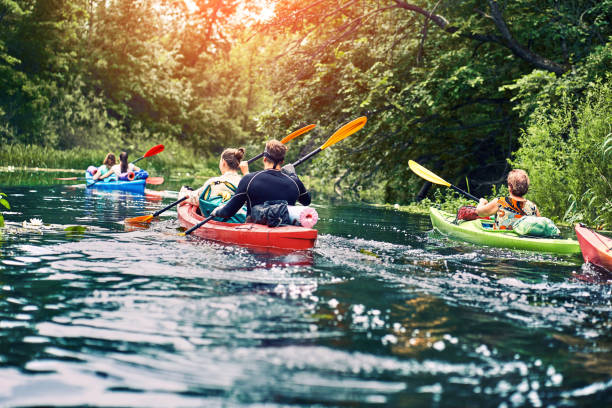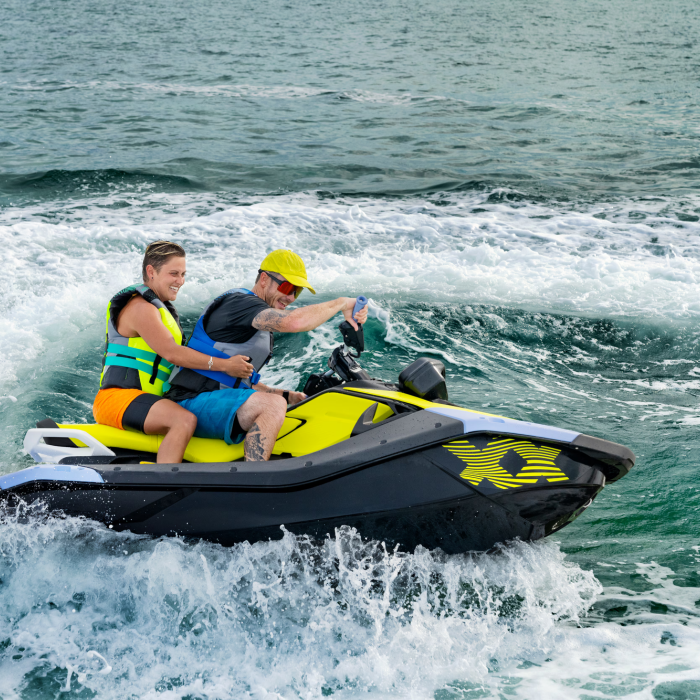Pontoon Boat
Pontoon boats have become a popular choice for those seeking leisurely days on rivers and lakes.
They offer a perfect mix of comfort and versatility, making them ideal for family outings, fishing trips, and watersports.

With their spacious decks, they can easily accommodate large groups, creating memorable moments with friends and family.
Pontoon boats are designed for shallow waters, making them perfect for lakes and rivers.
They are constructed with two or more aluminum tubes, which provide stability and buoyancy.
Modern designs come with various features and amenities, such as padded seating, shade structures, and even built-in sound systems, enhancing the overall experience on the water.

Some well-known brands like Lowe and Bennington offer a range of models to suit different needs and budgets.
From small, efficient models perfect for a quiet fishing trip to luxurious options for the ultimate party on the water, there's a pontoon boat for every preference.
Key Takeaways
- Pontoon boats are ideal for shallow waters
- Features and amenities enhance the boating experience
- Various brands and models suit different needs and budgets
History and Evolution of Pontoon Boats
Pontoon boats have a fascinating history and have gone through significant changes in design and innovation over the years.
The idea of using pontoons dates back thousands of years. Ancient civilizations like the Greeks and Polynesians used floating structures to transport goods and people.
Modern pontoon boats started gaining popularity in the 1950s. Ambrose Weeres, often credited as the inventor, built the first modern pontoon boat in 1951. He used welded steel barrels and a deck laid across them. This simple design marked the humble beginnings of pontoon boats we know today.
By the 1980s, advancements in materials and design led to the introduction of aluminum pontoons, replacing the heavier steel barrels. This made the boats lighter and more manageable.
Innovations in pontoon design have also included multi-chamber designs and the addition of lifting strakes to improve performance and stability on the water.

Notable advancements:
- Upholstered furniture and seating
- Expansive lounge areas
- Stand-up bars and sun pads
Modern pontoon boats now feature powerful engines, allowing for higher speeds and watersports.
Companies like Premier Marine and Bennington Marine have introduced luxury amenities and durable designs.
This includes features like LED lighting, high-end sound systems, and advanced navigation tools.
The evolution of pontoon boats has transformed them from simple floating platforms to luxurious, high-performance vessels. This journey showcases ongoing innovation and improvements in design, making them popular for recreation and leisure activities.
Types of Pontoon Boats
Pontoon boats come in various designs tailored to suit different needs, ranging from family outings to high-speed water sports.
Different types offer specific features, making them suitable for fishing, recreation, performance, or luxury.
Family and Recreational Pontoons
Family and recreational pontoons are designed with features that make them perfect for leisurely activities.
These boats typically have spacious decks, plenty of seating, and amenities like sun loungers and picnic tables.
They are stable and safe, making them ideal for family outings on the water.
Many models also include swim platforms and ladders, which are great for water activities like swimming and tubing. Some even come equipped with barbecue grills and stereo systems to enhance the recreational experience.
Key features:
- Large seating areas
- Swim platforms
- Picnic tables
- Barbecue grills
- Stereo systems

Fishing Pontoons
Fishing pontoons are equipped with specialized features to make fishing trips enjoyable and productive.
These boats often have swiveling fishing seats, rod holders, and bait storage areas.
Some models include advanced fish-finding electronics, ensuring a better fishing experience.
Fishing pontoons usually offer livewells to keep bait fresh and catches alive.
These boats combine the comfort of a pontoon with the practicality of a fishing vessel, making them a popular choice for anglers.
Key features:
- Swiveling fishing seats
- Rod holders
- Bait and tackle storage
- Fish-finding electronics
- Livewells

Performance Pontoons
Performance pontoons are built for speed and agility.
Often called tri-toons because they have three tubes instead of two, these boats can handle higher speeds and rougher waters better than traditional pontoons.
They are equipped with powerful engines and sportier designs, making them suitable for watersports activities such as skiing and wakeboarding.
These pontoons offer a thrilling ride while still providing some comfort for passengers.
Key features:
- Triple-tube hull design
- Powerful engines
- Sporty design
- Suitable for watersports
- Higher speed capability

Luxury and Premium Pontoons
Luxury and premium pontoons are designed with high-end features and materials to provide an upscale boating experience.
They often include plush seating, teak flooring, and state-of-the-art sound systems.
Some models offer built-in bars, full kitchens, and even bathrooms, making them the epitome of comfort on the water.
Key features:
- High-end materials
- Plush seating
- Teak flooring
- Advanced sound systems
- Built-in bars and kitchens
Pontoon Design and Construction
Pontoon design and construction focus on making the boat sturdy, versatile, and suited for various activities like fishing, watersports, and cruising.
Key aspects include the hull design, deck layouts, and the specific construction methods used.
Hull Design
The hull of a pontoon boat is usually supported by two or more metal tubes called pontoons.
These pontoons are often made from aluminum, which is both lightweight and strong. The pontoons provide buoyancy and stability, making the boat capable of handling different water conditions.
Pontoons can be plain or filled with foam for extra buoyancy. This helps prevent the boat from sinking if the hull is damaged.
Some designs feature hat-channel construction using extruded aluminum to improve stability without adding unnecessary weight. The shape and size of the pontoons also affect the boat's speed and handling.

Deck Layouts
Deck layouts on a pontoon boat are designed to maximize space and comfort.
Typically, they feature a large, flat deck area that can be customized with seating arrangements, storage compartments, and other amenities. Seating can be modular, allowing owners to rearrange or remove seats as needed.
Some pontoon boats are designed for specific activities. For example, fishing pontoons might have built-in rod holders, livewells, and tackle storage.
Watersports pontoons often include tow bars and ample seating space for passengers.
Decks are usually made from marine-grade plywood covered with protective coatings to resist water damage and provide a non-slip surface.

Construction Methods
Construction methods for pontoon boats vary, but they generally start with the selection of durable materials like marine-grade plywood, aluminum sheets, and resin.
These materials ensure the boat's longevity and performance.
The frame of the deck is often reinforced with aluminum hat-channels, which are bolted securely to the pontoons.
Welding is another critical construction method used to join the metal components, providing a robust and water-tight structure.
Some DIY guides and pontoon boat plans offer step-by-step instructions for building your own pontoon boat, emphasizing the importance of precise measurements and quality materials.
Quality control during construction is vital to ensure safety and durability.
Key Features and Amenities
Pontoon boats are equipped with various features and amenities that enhance comfort, functionality, and entertainment.
Key elements include spacious seating arrangements, ample storage options, advanced entertainment systems, and protective coverings like bimini tops.
Seating and Comfort Elements
Comfortable seating is a hallmark of pontoon boats. Models like the Premier 230 Intrigue offer plush, cushioned seats perfect for relaxing.
Many boats come with adjustable loungers and captain's chairs that provide optimal support and a great view.
Additionally, some pontoons include sun pads, allowing passengers to bask in the sun comfortably. Seating layouts vary, with options for large gatherings or intimate groups.

Storage Solutions
Storage is crucial on any boat. Pontoon boats feature under-seat compartments and built-in coolers for snacks and drinks.
Spacious bins under the seats house life jackets, water toys, and tow ropes. Deck boxes and small closets are ideal for personal items and fishing gear.
Boats like the Avalon Catalina Elite integrate smart storage solutions to keep the deck clutter-free.

Entertainment and Connectivity
Modern pontoon boats come with state-of-the-art entertainment systems. Bluetooth-enabled sound systems allow passengers to play music directly from smartphones.
Many boats feature high-quality speakers and subwoofers for an immersive audio experience. Large flat-screen TVs and satellite connections are also available, offering passengers the chance to watch movies or sports while out on the water.
Systems are often intuitive and easy to control, ensuring everyone can enjoy their favorite tunes or shows.
Boat Coverings and Bimini Tops
Protective coverings are essential for pontoon boats. Bimini tops provide shade, protecting passengers from UV rays and rain.
These tops are easy to deploy and retract, catering to different weather conditions. Several models offer full enclosures, creating a comfortable cabin space, ideal for cooler weather or overnight trips.
Coverings also protect the boat's interior and electronics from damage, prolonging the boat's life.
Performance and Handling
Pontoon boats have advanced significantly in terms of speed and agility. They provide a smooth ride, impressive horsepower, and specialized performance packages that enhance their overall capabilities.
Engine and Horsepower
Performance pontoon boats need powerful engines. Modern models often feature powerful outboard motors. For example, some pontoons come with a 300 hp Evinrude G3 engine, which can push the boat to speeds over 48 mph.
Engines with high horsepower, like a 3.2-liter V6 that generates 300+ hp, are designed to offer superior speed and acceleration. This makes them ideal for water sports or high-speed cruising. Multiple gear case options and advanced fuel injection systems are key elements that contribute to the engine's efficiency and reliability.

Handling on Water
Handling has greatly improved in performance pontoon boats. These boats can carve turns and handle similarly to many fiberglass boats. Enhanced designs like lifting strakes, under-deck skins, and reinforced nose cones aid stability.
Boats also come with features like the Teleflex SeaStar Power Assist steering, which makes navigating sharp turns easier. These characteristics ensure that the boat banks smoothly into turns, providing a better ride and feel, even at high speeds.
Performance Packages
Performance packages are vital for enhancing the capabilities of pontoon boats. Many boats feature Sport Handling Packages (SHP), which include multiple enhancements for better performance.
For instance, Manitou’s SHP includes wide, positive-angle lifting strakes that improve the boat’s ability to get onto plane swiftly. Other packages might include under-deck skins to reduce drag and improve efficiency. Reinforced nose cones also play a part in boosting handling and speed.
Popular Pontoon Boat Brands
In the world of pontoon boats, several brands stand out due to their reputation for quality, performance, and innovation. This section explores some of the top manufacturers: Bennington, Sun Tracker, Harris, Lowe, and Sea-Doo.
Bennington Pontoons
Bennington is known for producing high-end pontoon boats with exceptional craftsmanship. Established in 1997, Bennington quickly gained a reputation for luxury and performance. Their boats feature stylish designs and can reach impressive speeds.
Key models include the Bennington 30QX, which offers twin-engine options capable of hitting over 60 mph. Customers appreciate the brand's attention to detail and customizations, making it a favorite among those seeking a premium boating experience.
Sun Tracker Series
Sun Tracker is a popular choice for those looking for affordable yet reliable pontoon boats. Their models are designed with family fun and fishing in mind. Sun Tracker boats are known for their durability and excellent value.
The Sun Tracker Party Barge® series is a staple in their lineup, offering spacious deck areas and comfortable seating. Sun Tracker boats often come with features like fishing stations, livewells, and swim platforms, making them versatile for various activities.
Harris Pontoons
Harris has been manufacturing pontoon boats for over 60 years. Known for their innovation and quality, Harris pontoons are designed for both casual outings and high-performance activities.
Their Crown Series boats are particularly noteworthy, offering luxurious amenities and robust construction. Harris boats often include advanced features such as integrated entertainment systems and high-end upholstery, catering to those who desire both comfort and performance on the water.
Lowe Boats
Lowe Boats offers a range of pontoon boats that cater to both leisure and fishing enthusiasts. Established in 1971, Lowe has a long history of reliability and customer satisfaction. Their pontoon boats are known for their rugged build and affordability.
The SS Series is a popular choice among families, featuring spacious designs and durable materials. Lowe pontoons often include thoughtful touches like ample storage, comfortable seating, and optional fishing packages.
Sea-Doo and Recreational Models
Sea-Doo, primarily known for their personal watercraft, have ventured into the pontoon boat market with innovative and fun designs. The Sea-Doo Switch is a standout model, offering a unique and modular approach to pontoon boating.
With its customizable deck layout and efficient handling, the Switch appeals to those who want a versatile and easy-to-use boat. Sea-Doo's reputation for performance and reliability extends to their pontoon boats, making them a compelling choice for recreational boaters.
For more information on Sea-Doo models, check out the Sea-Doo Switch review.
Purchasing Considerations
When buying a pontoon boat, it's crucial to weigh factors such as quality, pricing, and warranty support. These considerations help ensure a worthwhile purchase.
Assessing Quality and Reliability
Quality is key when choosing a pontoon boat. Look for durable materials, such as aluminum pontoons, which resist corrosion. Inspect the construction of the boat, including the welds and joints.
Reliable brands often have a solid reputation for craftsmanship. Reading user reviews and speaking with seasoned boat owners can provide insights.
Check for essential features like strong railings, high-quality seating, and reliable engines. These elements influence the boat’s performance and longevity.
A well-made boat will also come with a comprehensive owner’s manual, detailing maintenance tips. Proper maintenance prevents costly repairs down the road.
Understanding Pricing and Value
Pontoon boat prices vary based on size, features, and new versus used conditions.
Small boats for calm waters range between 17 to 19 feet and are more affordable. For lakes and rivers without large waves, boats between 20 to 22 feet work well.
Larger boats, sized 23 to 28 feet, are suitable for rough waters. While more pricey, they provide better stability and space.
It's important to consider the total cost, including accessories and maintenance. Some boats might have a higher upfront cost but lower long-term expenses due to better fuel efficiency and durable materials.
Warranty and Support
Purchasing from a reputable dealership usually ensures better warranty options and support.
Many manufacturers offer warranties on their boats, with some even providing limited lifetime warranties on certain parts. Understanding the warranty coverage is essential. It should cover major components like the engine, pontoons, and electrical systems.
Additionally, check if the dealer provides support for repairs and maintenance. This can save time and money when dealing with potential issues.
Look for a dealership that offers excellent customer service and has a well-stocked parts inventory. This accessibility ensures a smoother and more enjoyable boating experience.
Maintenance and Care
Maintaining and caring for a pontoon boat requires regular attention to cleaning, engine checks, and proper storage, especially during the winter season. Proper care extends the life of the boat.
Regular Maintenance
Regular maintenance is key to keeping a pontoon boat in good condition.
First, wash your pontoon boat regularly.
Rinse off loose dirt and scrub with a mix of boat soap and water. For stubborn stains, use specialized cleaners.
Inspect the engine frequently.
This includes checking for leaks, oil levels, and ensuring the cooling system is working properly. A well-maintained engine is crucial for reliable performance.
Make sure to check the battery charge before each use. A charged battery ensures your boat starts reliably.
Additionally, check the fire extinguisher to ensure it is fully charged and accessible.
Finally, always cover the boat when not in use.
A cover protects from weather elements and reduces the need for frequent cleaning.
Winterization and Storage
Preparing your pontoon boat for winter is essential for preventing damage.
First, winterize the engine by flushing out any water and adding antifreeze. This prevents freezing and cracking.
After that, clean and dry the boat thoroughly before storage.
Any remaining water or dirt can cause mold or corrosion.
Store the boat in a dry, covered area if possible.
This provides the best protection from snow and ice. If indoor storage isn't available, use a high-quality cover designed for winter conditions.
Next, remove and store upholstery separately to prevent damage from freezing temperatures.
Check warranties to see if they offer any specific winter storage provisions.
Upholstery and Material Care
Proper care of upholstery and materials can greatly extend their lifespan.
Start by cleaning the interior regularly. Use appropriate cleaners and avoid harsh chemicals.
If your boat has fiberglass components, clean them with soap and water, then rinse thoroughly. For aluminum parts, use a special aluminum cleaner.
After that, cover the upholstery between uses to protect it from UV damage and weather. This reduces wear and tear.
Lastly, check for any tears or damage regularly. Addressing small issues early can prevent larger, more expensive repairs later on.
Boating Safety and Regulations
Operating a pontoon boat requires attention to several key regulations and safety measures.
Safety Equipment
Pontoon boats must carry essential safety equipment on board.
This includes life jackets for all passengers, a fire extinguisher, and a first aid kit. It’s important to follow guidelines for equipment maintenance to ensure everything is functional.
Carbon Monoxide Hazards
Carbon monoxide can build up under the deck, especially when the engine is running.
Make sure to ensure proper ventilation and be aware of symptoms of carbon monoxide poisoning.
Capacity Limits
Each pontoon boat has a maximum capacity rating that includes both weight and the number of passengers.
Overloading the boat can lead to dangerous situations, so always adhere to these limits.
Right-of-Way Rules
Boaters must follow the right-of-way rules to avoid collisions.
This includes knowing when to yield and how to pass other boats safely.
Operator Requirements
Different states have varying requirements for the minimum age of boat operators.
Make sure to check the local laws to ensure compliance.
Alcohol and Boating
Operating a pontoon boat under the influence of alcohol is illegal and dangerous.
Be aware of the strict regulations on boating under the influence to protect yourself and others.
Eco-Friendly and Electric Options
Electric pontoon boats are gaining popularity due to their lack of emissions and low maintenance.
Innovations in this field offer efficient, quiet, and clean power, making them a sustainable choice for boating enthusiasts.
Electric Pontoon Models
One standout model is the Crest Current. This eco-friendly pontoon boat features direct-drive technology, which provides efficient and clean power that requires minimal maintenance.
It includes a captain’s chair with armrest, L-shaped sunpad, and its unique helm and gauges to monitor speed and battery life. It's equipped with an ePropulsion Navy 3.0 motor and an E175 battery, ensuring smooth operation in both salt and freshwater.
Other notable models include the Princecraft Brio E-17, which utilizes a Torqeedo motor and solar batteries. This setup results in a 9.9 HP output, making it an excellent option for those concerned about the environment.
Sustainable Boating Practices
Sustainable boating practices are essential for reducing environmental impact.
Using electric engines instead of gas-powered ones cuts down emissions, and leaks, and reduces the need for fuel storage.
Boaters can also practice sustainability by maintaining their boats to prevent harmful discharges into the water.
Additionally, boaters should use eco-friendly cleaning products to avoid releasing harmful chemicals into the waterways.
Installing solar panels on pontoon boats is another sustainable practice. These panels can charge batteries and power onboard electronics, further reducing reliance on fossil fuels.
Frequently Asked Questions
When it comes to pontoon boats, there are many things to think about. From purchasing to renting, each aspect requires careful consideration.
What should one consider when looking for used pontoon boats for sale?
When buying a used pontoon boat, check for maintenance records and any signs of wear or damage.
Inspect the pontoons for leaks or dents. Ensure that the engine runs smoothly and get a professional inspection if possible.
How do rental costs vary for pontoon boats?
Rental costs for pontoon boats can vary depending on location, duration, and the season.
In popular tourist areas, prices are usually higher during peak seasons. Renting for a half-day or full-day can affect the cost, as well as additional amenities offered.
What are some common features found in pontoon boats with bathrooms?
Pontoon boats with bathrooms typically feature a fully enclosed space with a portable toilet or a marine-grade toilet.
Some may also include a small sink, storage space, and even a privacy curtain or lockable door for added comfort.
What price range can one expect when purchasing a new pontoon boat?
The price for a new pontoon boat can range from $15,000 to over $50,000.
Entry-level models with basic features are more affordable, while luxury models with high-end amenities and powerful engines can be at the higher end of the scale.
What are some effective tips for fishing from a pontoon boat?
For fishing from a pontoon boat, use the boat's stability to your advantage.
Equip the boat with rod holders, a livewell, and fish finders. Position the boat in shallow or deep waters as needed and use the ample deck space for storing gear and tackle.
What are the common drawbacks of owning a pontoon boat?
Some common drawbacks of owning a pontoon boat include difficulties in handling choppy waters. They also have lower top speeds compared to other types of boats.
Storage and maintenance can also be challenging. They require significant space and regular upkeep.
Charlie is Editor-in-Chief of Sea Magazine







